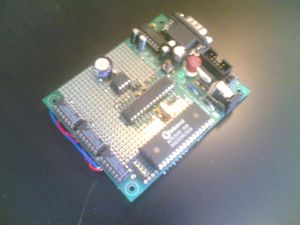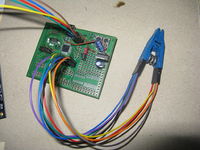Serprog: Difference between revisions
m (→Software: fix whitespace issue) |
|||
| Line 56: | Line 56: | ||
=== Software === | === Software === | ||
==== Required software ==== | |||
To make it work you need: | To make it work you need: | ||
* flashrom from svn | * flashrom from svn | ||
* [https://git.gitorious.org/gnutoo-personal-arduino-projects/serprog-duino.git serprog-duino which runs on the arduino] | * [https://git.gitorious.org/gnutoo-personal-arduino-projects/serprog-duino.git serprog-duino which runs on the arduino] | ||
* The avr toolchain(avr-gcc, avr-libc,make etc...) | * The avr toolchain(avr-gcc, avr-libc,make etc...) | ||
==== Running flashrom ==== | |||
./flashrom -p serprog:dev=/dev/ttyACM0:57600 | |||
=== Advantages and disadvantages === | === Advantages and disadvantages === | ||
Revision as of 22:29, 23 April 2012
This page is a first draft only and serves to collect information about the serprog protocol and the programmers implementing it.
Protocol
See serprog-protocol.txt in the source tree. It is designed to be compact and allow efficient storage in limited memory of programmer devices.
There is a draft for an extension of the serprog protocol to SPI. FIXME: Link there.
Hardware
AVR flasher by Urja Rannikko

The Prototype RS232 AVR parallel flash programmer Urja Rannikko was the first implementation of the serprog protocol.
FIXME: AVR source code is somewhere in the coreboot mailing list archives...
AVR flasher by eightdot
FIXME: Link?
Arduino Mega flasher by fritz
Arduino Uno flasher by GNUtoo
This flasher require the following hardware parts:
- An arduino uno and its usb cable
- some wires(optionally some connectors to solder on(for easier plugin and more reliability)
- a 10k resistor
- a flash chip to flash
Building
Left pins of the BIOS chip: -------------------------------------------------------- [pin1 of the bios chip] /CS<->10k resistor<->VCC [pin1 of the bios chip] /CS<->Arduino pin10(SS, PORTB2) [pin2 of the bios chip] DO<->Arduino pin12(MISO, PORTB4) [pin3 of the bios chip] /WP<->VCC [pin4 of the bios chip] GND<->GND on the power pins Right pins of the BIOS chip: -------------------------------------------------------- [pin8 of the bios chip] VCC<->+3.3V on the power pins of the Arduino [pin7 of the bios chip] /HOLD<->VCC [pin6 of the bios chip] CLK<->Arduino pin13(SCK, PORTB5) [pin5 of the bios chip] DIO<->Arduino pin11(MOSI, PORTB3) The Bios chip used is a W25X80. The Arduino is an arduino uno.
Software
Required software
To make it work you need:
- flashrom from svn
- serprog-duino which runs on the arduino
- The avr toolchain(avr-gcc, avr-libc,make etc...)
Running flashrom
./flashrom -p serprog:dev=/dev/ttyACM0:57600
Advantages and disadvantages
- While the speed isn't that great(less than 10 minutes for reading+writing+verifying a 1M chip), there is huge room for improvements in the source code.
- it is made of very commonly available parts(if you can find an arduino uno, you will be able to build it).
InSystemFlasher by Juhana Helovuo
This is one uses a modified serprog version to talk to SPI devices via serial over USB. Details can be found in the coreboot wiki and in this coreboot mailing list thread.
atmegaXXu2-flasher by Stefan Tauner
Like the InSystemFlasher this one uses LUFA on an AVR microcontroller to tunnel the serial data over USB. To be updated when flashrom's serprog module has the needed changes merged to do SPI communication.
